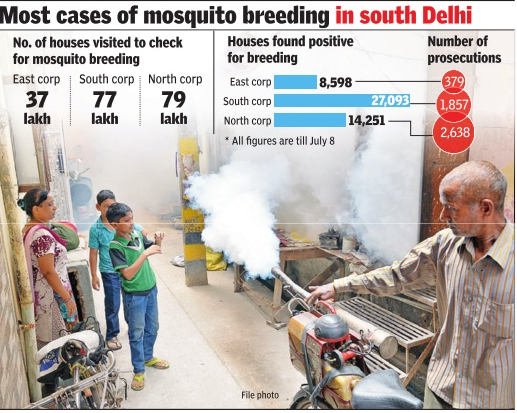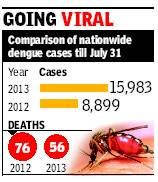Dengue: India

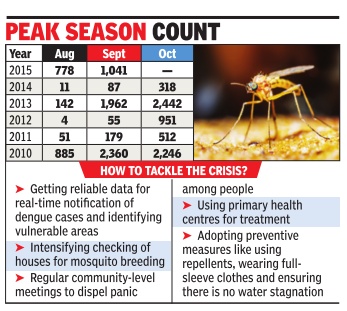
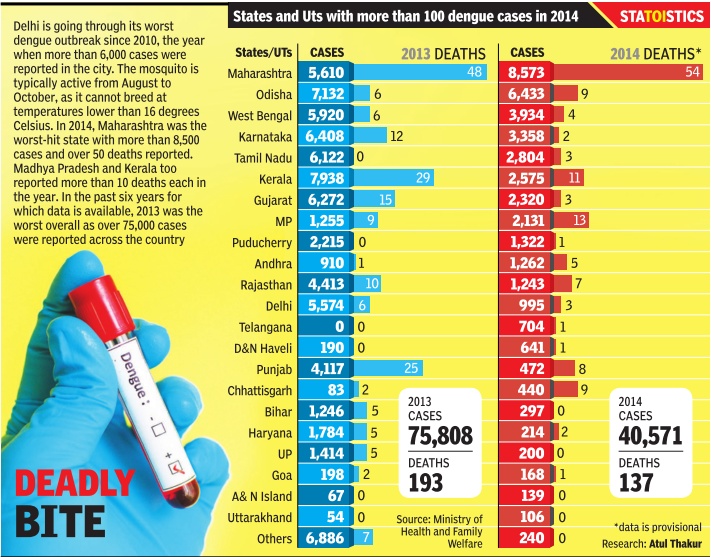
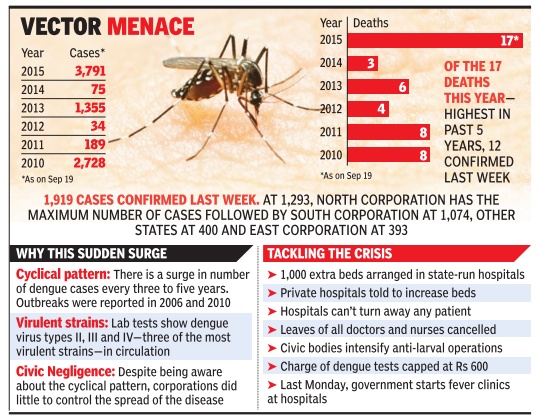
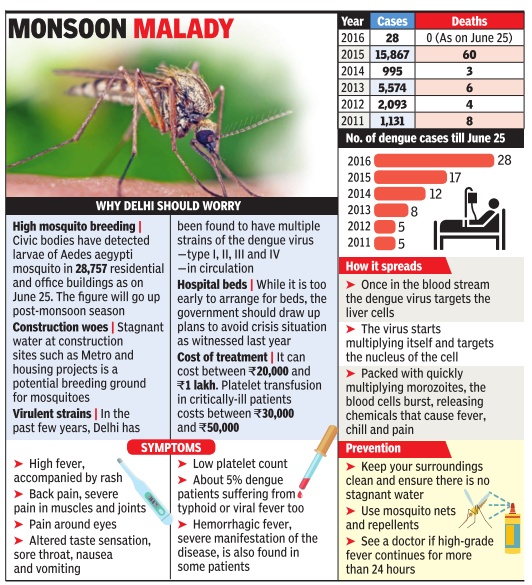
This is a collection of articles archived for the excellence of their content. |
Contents |
The extent of the problem
2019-2025

From: Chethan Kumar, June 23, 2025: The Times of India
See graphic:
Dengue cases and deaths in India, 2019-2025
Fight against dengue
2012-16: a losing battle in Delhi
AlokKNMishra|5-year data show corps are losing dengue battle|Jul 12 2017: The Times of India (Delhi)
5-year data show corps are losing dengue battle
New Delhi While corporations claim to have initiated a crackdown on mosquito breeding, this is turning out to be the worst year in the last five in terms of dengue and chikungunya spread: till July 8, the city has reported 110 chikungunya and 60 dengue cases. In 2016, just 14 cases of dengue were reported by this time. In 2015, the number was 21, whereas it was 13 a year before that. As far as chikungunya is concerned, no cases were reported by this time in the last three years. However, in 2012, five chikungunya cases were recorded till July 8.
Five-year data on vectorborne diseases have thrown up an interesting pattern: while their incidence remains negligible till May , the numbers pick up thereafter -the upward trajectory continues till October. Sample this: from 2012 to 2016, no dengue cases were reported in January , except the first month of 2013 when there were two cases. In January 2017, there were six dengue and 20 chikungunya cases. No chikungunya case was reported in January of any of the last five years.
North corporation mayor Preeti Agrawal told TOI: “Domestic breeding checkers are conducting door-to-door surveys. They are checking rooftop tanks and coolers and spraying anti-larva agents in stagnant water on a warfooting.“ The results are obviously not there, though. Agrawal said the corporation had a plan in place for monsoon. She also denied reports that the three civic bodies had underreported cases of vector-borne diseases. “ A majority of patients are from neighboring areas who came to the capital for treatment,“ she said.
According to an official report released by the civic bodies, north corporation areas have reported three cases of chikungunya till July 8, south corporation two and east corporation four. Three cases have been reported from the Delhi cantonment area. There have been no reports from NDMC areas. An EDMC official said addresses of 55 chikungunya patients could not be found. Another 43 cases were placed under the “untraceable after investigation“ category .
According to the same report, only eight cases of dengue were reported from areas under the three corporations. The south corporation, meanwhile, has set up a monsoon control room at its headquarters and one each at every zone to combat any emergency arising due to rain. Citizens can call in at a toll-free number (1266) or two other numbers -23220016 & 23220010. “We have put up details of mosquito breeding checkers online,“ Neema Bhagat, EDMC mayor, said.
2013
Alarming 80% rise in dengue cases in 2013
Durgesh Nandan Jha TNN
The Times of India 2013/08/21
New Delhi: Dengue cases have risen alarmingly across the country this year, with data showing an 80% rise in the disease till July 31 as compared to the same period last year.
India has recorded 15,983 dengue cases so far in 2013 as compared to 8,899 cases in the corresponding months last year, latest health ministry data shows. But the good news is, while the cases have risen sharply, fatalities have actually declined — 56 as compared to 76 last year.
Kerala reported most dengue cases at 5,801, followed by Karnataka (3,775), Tamil Nadu (3079) and Maharashtra (961) till end-July. Delhi witnessed a sharp rise in cases over the last few weeks, with the total this year touching 54. No one has died due to dengue in the capital so far.
‘Several factors for spread of dengue’
“There is no single reason for the increase in dengue cases. It is governed by various man-made and environmental factors including unprecedented growth in population, unplanned and rapid urbanization and inadequate waste management,” union health minister Ghulam Nabi Azad stated in a written reply in the Lok Sabha on Tuesday.
Increasing mobility of the population and poor infrastructure to monitor mosquito breeding were some other reasons cited by the health minister. Azad said guidelines for clinical management of dengue cases have been sent to the states for circulation in hospitals and rapid response teams have been formed.
Dengue, termed by many experts as the world’s most rapidly spreading mosquito-borne viral disease, is caused by four serotypes. While type I and III are milder in nature causing classic dengue fever and fever without shock, respectively, dengue type II and IV are considered deadly. These cause fever, bleeding and a drop in platelet count. Researchers say severe dengue cases, dengue hemorrhagic fever and dengue shock syndrome, started showing up in India since 1988.
“A reason behind the increased frequency could be the presence of many strains of the virus. It exposes people already infected to become susceptible to infection as they are not immune to all the subtypes,” said Dr Ekta Gupta, clinical virologist at the Institute of Liver and Biliary Sciences (ILBS).
Experts say construction sites are a major area of mosquito-breeding followed by government buildings and water tanks. “In Mumbai, the municipal body, charges heavy fines if mosquitoes are found to be breeding at a site. The building’s completion certificate is stalled till the fine is paid. Similar steps should be taken in cities like Delhi,” said Dr Jagdish Prasad, director general of health services.
2013-18: dengue cases in Delhi
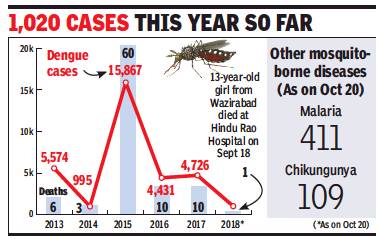
From: DurgeshNandan Jha, October 23, 2018: The Times of India

Dengue,
Malaria and
Chikungunya
From: DurgeshNandan Jha, At 2,774, city’s dengue count lowest since 2014, December 19, 2018: The Times of India
See graphic:
2013-18- dengue cases in Delhi
Mosquito-borne diseases in Delhi: 2013-18
Dengue,
Malaria and
Chikungunya
2015: Delhi
The Times of India, Oct 14 2015
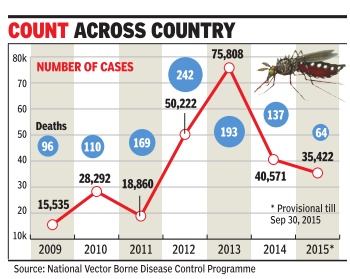
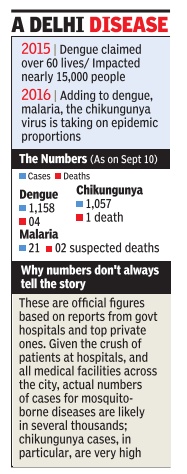
Sushmi Dey
In 2015, Delhi accounted for at least 30 deaths due to dengue, nearly half of the total casualties reported from across the country . Till Octo ber 10, municipal authorities confirmed 10,683 cases, more than the worst dengue outbreak of 1996 with 10,252 cases and 423 deaths. Though hospitals have reported a dip in dengue cases, the incidence of dengue has not ended.
Sources in the ministry said the Centre has sent a “strong message to the Delhi government asking them to act aggressively with swine flu and be prepared with all infrastructure to ensure there is no repeat of a dengue-kind of situation with swine flu“. The ministry will also issue guidelines to the Delhi government on control of swine flu including on vaccination, infection control and standard treatment protocols.
Besides, the Centre is also working to strengthen the overall strategy to deal with tropical and vector borne diseases and create a system wherein states can be made accountable on a regular basis for not doing enough.
“Health is a state subject and states have to take proac tive measures. We can only guide them and help them in their efforts. But we are still trying to develop a mechanism wherein at least we can ask them for a regular update or report on what they are do ng. This is basically in pub ic interest to ensure that we do not wake up suddenly to know states have not done enough,“ a senior official in he health ministry said.
He added there are strict directives from Nadda to de velop a strong mechanism to avoid rise in morbidity as well as death toll.
The health ministry is also holding talks with other ministries such as urban de velopment and HRD to take proactive sanitation measures and rope in school kids as brand ambassadors for spreading awareness about cleanliness. The government also plans to introduce separate chapter in school text books that will deal with vec or-borne diseases and create awareness about symptoms and management of diseases ike dengue, malaria etc.
2017, Aug: Dengue, malaria, chikungunya count worst in 4 years
AlokKNMishra, Chikungunya count for Aug worst in 4 yrs, August 15, 2017: The Times of India

Dengue, Malaria Cases Up Too
The capital has witnessed a spurt in dengue and chikungunya cases in August, considered a crucial month for checking the vectorbrone diseases. A similar trend was recorded in the past two years, too, leading to an outbreak in the following months.
According to the latest report, 251 dengue, 193 malaria and 174 chikungunya cases have been reported till August 12 -the highest count for the same period since 2013.
Delhi witnessed a massive outbreak of dengue and chikungunya in September and October of 2015 and 2016. In August 2015, 778 cases of dengue were reported and, just a month later, 6,775 cases. A similar pattern was seen in 2016, when 652 cases were reprted in August, 1,362 in September and 1,517 in October.
The cases are growing at an alarming rate this year too despite the civic bodies claiming to have undertaken an aggressive drive to check mosquito breeding. In July , the city had recorded the hig hest number of such cases in the past five years.
“The corporations have employed domestic breeding checkers (DBCs) but they are not well paid and lack the enthusiasm as they are not paid regularly ,“ said former councillor Jagdish Mamgani.
Lack of cooperation from common people is also a reason, a north corporation official said. Many government instituions next to residential areas are also found to be major breeding grounds for mosquitoes. “Many of them have been issued challans,“ he said.
The checkers often complain many households do not allow them to enter and they end up checking just coolers placed outside.
The corporations, however, claimed they were cracking down on mosquito breeding. “Most cases have been reported from outside the corporations' areas,“ said north corporation mayor Preeti Agrawal. “I have requested senior officers and the public health department to monitor it better.“
2018: dengue count lowest since 2014
Four Deaths Reported Against 10 Each In Last 2 Yrs
Delhi has recorded 2,774 cases of dengue in 2018, (as on December 18, 2018) — the lowest since 2014 when 895 cases of the mosquito-borne disease were reported in the city. In 2015, 2016 and 2017, the cases shot up significantly, affecting 15,867, 4,431 and 4,726 people, respectively.
Dr B K Hazarika, the municipal health officer, told TOI that lower rainfall was an important factor for reduction in the count this year. “Other factors that could have influenced this positive trend are early screening of houses for mosquito breeding and increased awareness among people to keep their surroundings clean,” he added.
Dengue has been a major public health concern in Delhi with recurrent outbreaks, prompting people to rush to hospitals, particularly in the postmonsoon season when mosquito breeding is at its peak. In rare cases, the ailment can be fatal.
In 2015, 60 people died due to dengue in Delhi, as per the municipal data. But hospitals claimed that the actual figure was much higher. In 2016 and 2017, the corporation claimed 10 people each died due to dengue. This year, four deaths have been recorded so far.
Neena Valecha, director of National Institute of Malaria Research (NIMR), said less complications and the drop in the mortality rate was due to predominance of type-III strain of dengue virus. Dengue strains are of four types — type-I causes classic dengue fever, type-II leads to haemorrhagic fever with shock, type-III triggers fever without shock and type-IV results in fever without shock or profound shock.
The corporation data also shows that the number of chikungunya and malaria cases is significantly lower this year compared with previous years. Several factors, including temperature, moisture and rainfall, contribute to the rise in dengue cases, says an expert. The disease also follows a cyclical trend, which is well documented.
“We cannot say whether dengue cases will remain low or peak up next year. But we must be equally prepared to deal with any situation. Public support is also needed,” said Hazarika.
The average lifespan of an Aedes mosquito is two weeks, during which it can lay eggs three times. About 100 eggs are produced each time. According to entomologists, eggs can lie dormant in dry conditions for up to nine months after which they can hatch if exposed to favourable conditions, which is water and food.
“If the key habitats — overhead and curing tanks — are cleared of these eggs during the dry season, the chances of outbreaks during wet months can be reduced significantly. But the authorities alone cannot tackle the crisis,” said a municipal health officer.
